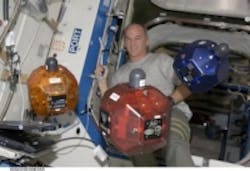NASA to use Google’s 3D Project Tango devices in space station robots
NASA has announced plans to equip ball-shaped floating robots on its International Space Station (ISS) with Google’s Project Tango 3D imaging smartphones.
Currently onboard the ISS, NASA’s Synchronized Position Hold, Engage, Reorient, Experimental Satellites, or SPHERES, are small hovering robots that could eventually be used to take over daily tasks for astronauts and possibly take over risky tasks outside the vessel, according to Reuters. Google’s Project Tango devices were launched in a cargo spacecraft headed for the ISS on July 11 to provide 3D mapping capabilities for the robots.
MORE ARTICLES
(Slideshow) Six unique ways 3D imaging helped solve problems
NASA’s Mars Curiosity rover celebrates Martian Year anniversary with a selfie
These devices contain customized hardware and software designed to track the full 3D motion of the device while simultaneously creating a map of the environment. Image sensors in the device will enable 3D measurements while updating its position and orientation in real-time, and combining that data into a single 3D model of the space around the user. For the device's image sensors, OmniVision Technologies, Inc. is supplying its OV4682 and OV7251 CMOS image sensors. OV4682 records both RGB and IR information, the latter of which is used for depth analysis. OmniVision's OV7251 global shutter sensor is used for the device's motion tracking and orientation. In addition, the Myriad 1 computer vision processor from Movidius helps to process computer vision data.
The SPHERES robots, which are reportedly inspired from a scene from the movie Star Warswhere Luke Skywalker spars with a hovering globe, can be guided around the space station’s microgravity interior, propelled by tiny blasts of CO2 at about an inch per second.
Originally sent to the space station in 2006, the SPHERES were equipped with modified store-bought smartphones, but following the development of the Tango devices, the ISS team decided to equip the robots with Google’s latest product.
"This type of capability is exactly what we need for a robot that's going to do tasks anywhere inside the space station," Smart SPHERES project manager Chris Provencher told Reuters. "It has to have a very robust navigation system.”
View the Reuters article.
Share your vision-related news by contacting James Carroll, Senior Web Editor, Vision Systems Design
To receive news like this in your inbox, click here.
Join our LinkedIn group | Like us on Facebook | Follow us on Twitter | Check us out on Google +
About the Author

James Carroll
Former VSD Editor James Carroll joined the team 2013. Carroll covered machine vision and imaging from numerous angles, including application stories, industry news, market updates, and new products. In addition to writing and editing articles, Carroll managed the Innovators Awards program and webcasts.
